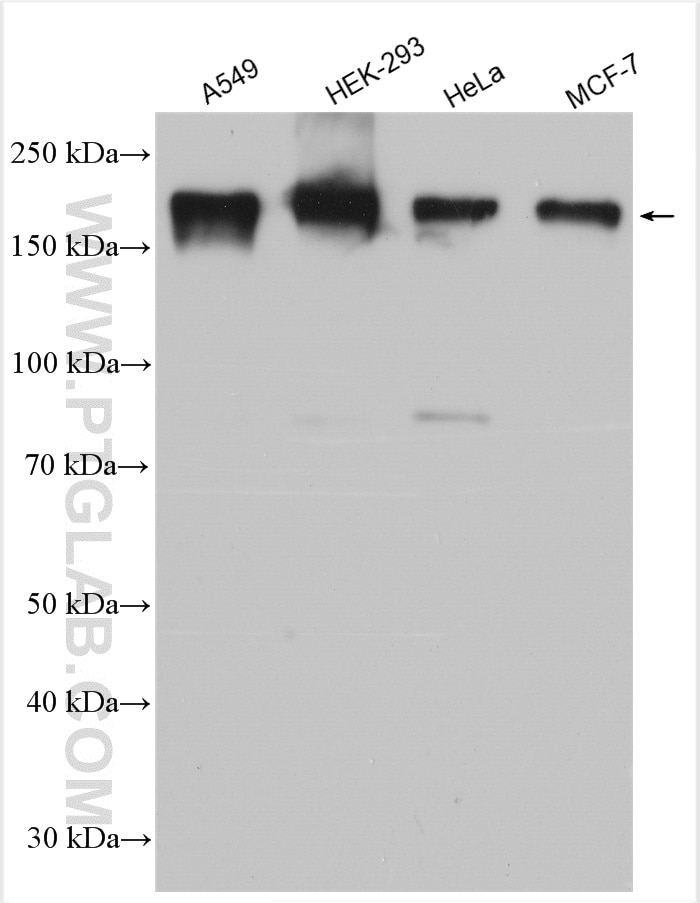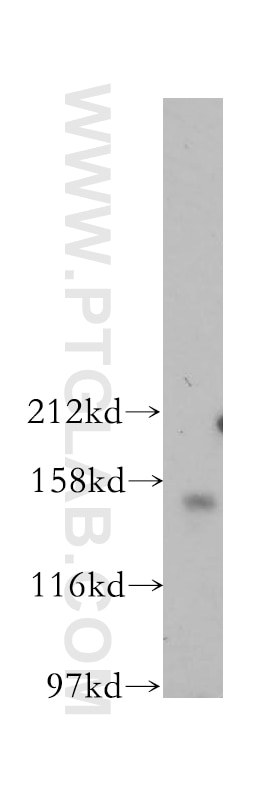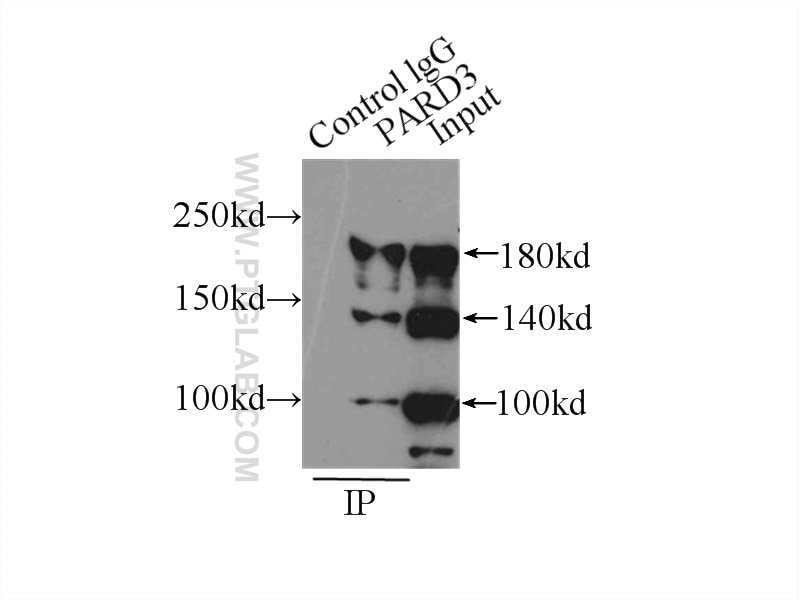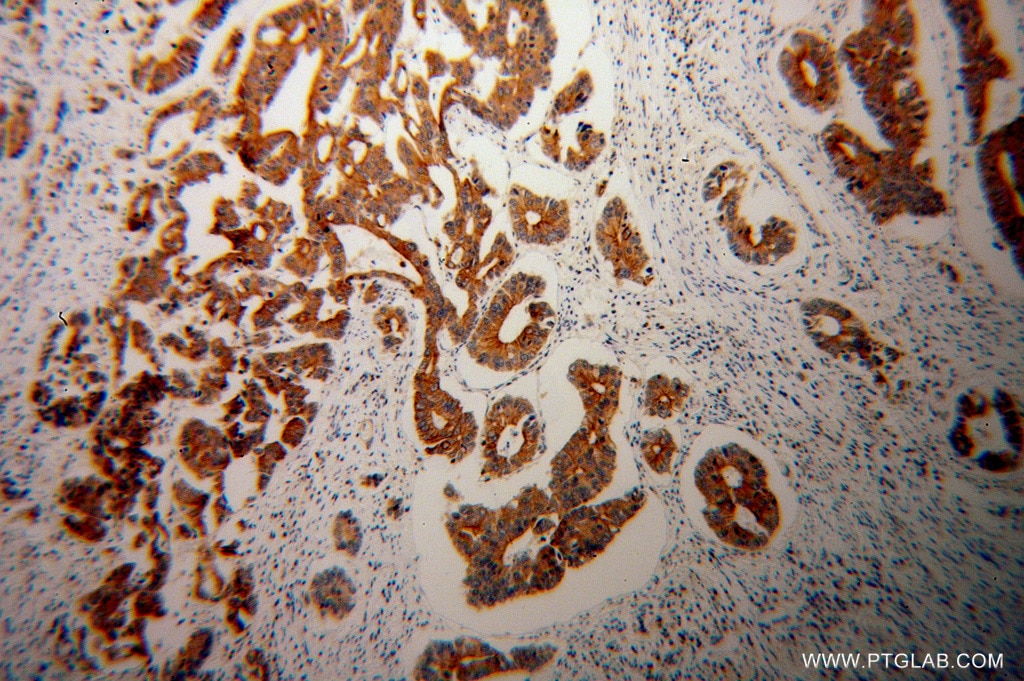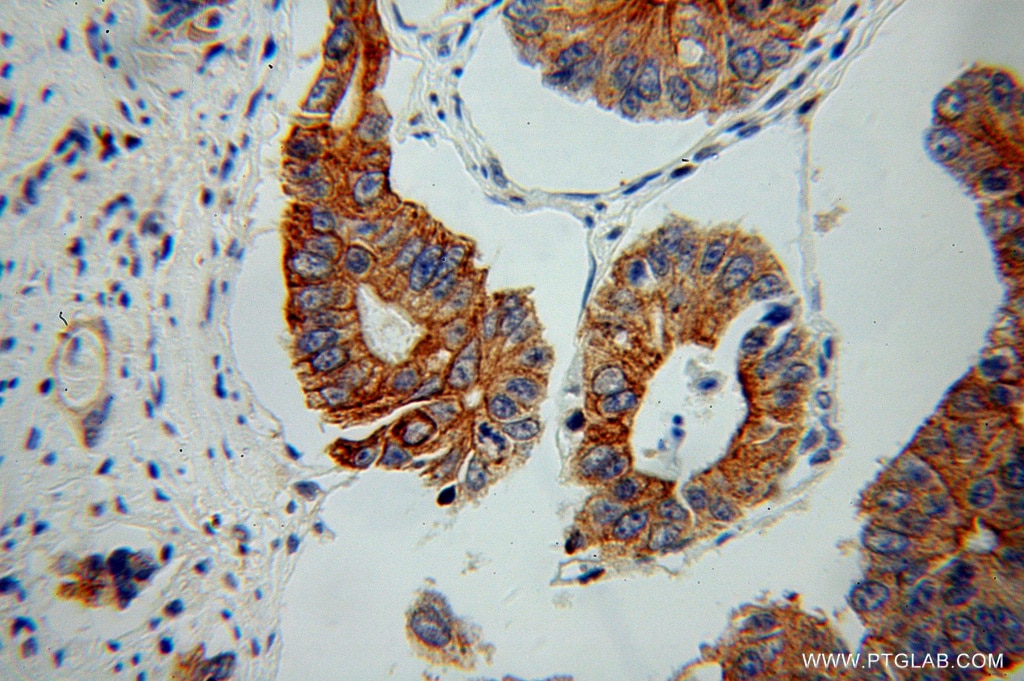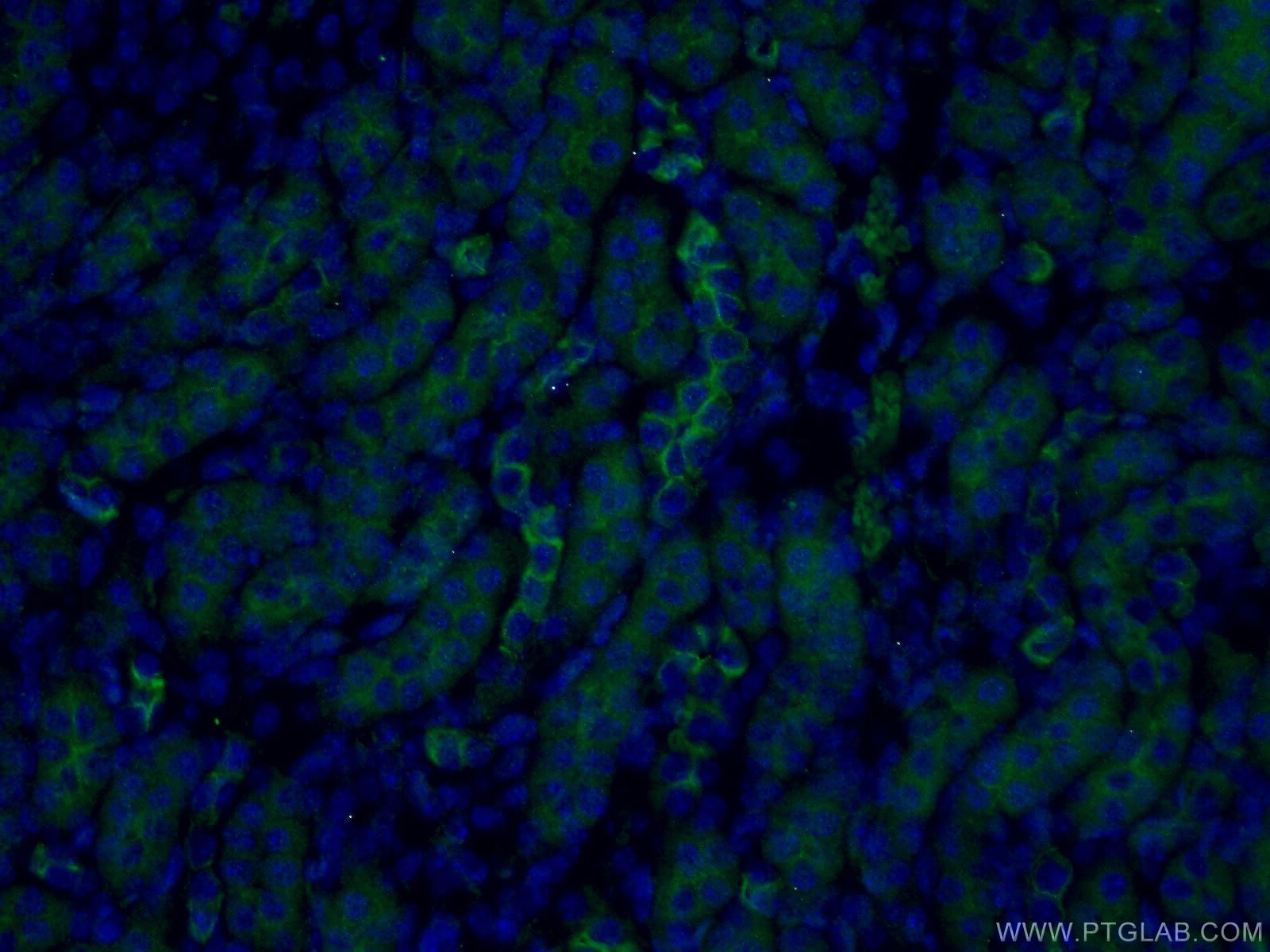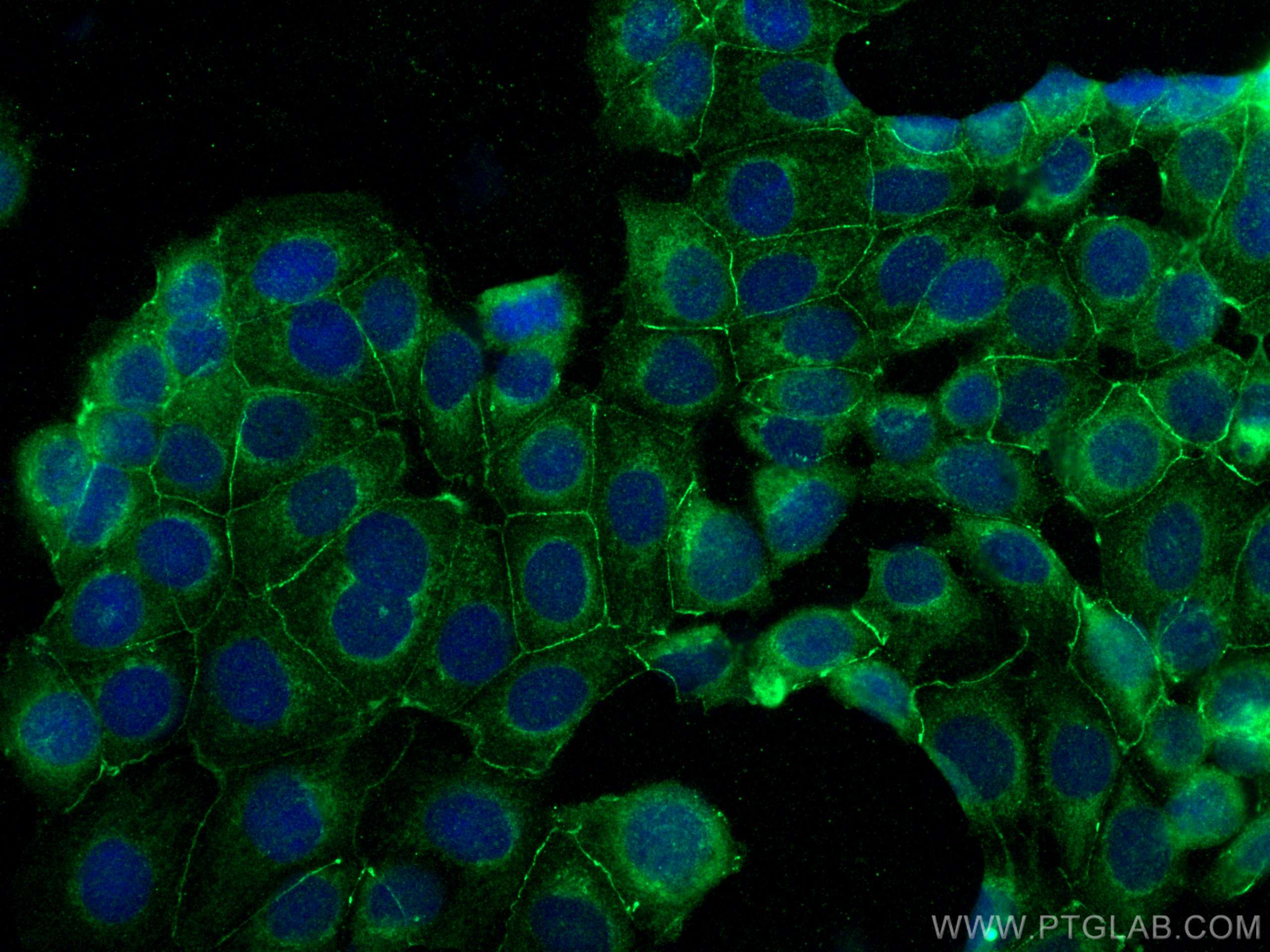- Featured Product
- KD/KO Validated
PARD3 Polyklonaler Antikörper
PARD3 Polyklonal Antikörper für WB, IHC, IF/ICC, IF-P, IP, ELISA
Wirt / Isotyp
Kaninchen / IgG
Getestete Reaktivität
human, Maus und mehr (2)
Anwendung
WB, IHC, IF/ICC, IF-P, IP, CoIP, ELISA
Konjugation
Unkonjugiert
Kat-Nr. : 11085-1-AP
Synonyme
Geprüfte Anwendungen
| Erfolgreiche Detektion in WB | A549-Zellen, HEK-293-Zellen, HeLa-Zellen, MCF-7-Zellen |
| Erfolgreiche IP | MCF-7-Zellen |
| Erfolgreiche Detektion in IHC | humanes Kolonkarzinomgewebe Hinweis: Antigendemaskierung mit TE-Puffer pH 9,0 empfohlen. (*) Wahlweise kann die Antigendemaskierung auch mit Citratpuffer pH 6,0 erfolgen. |
| Erfolgreiche Detektion in IF-P | Mausnierengewebe, Maushirngewebe |
| Erfolgreiche Detektion in IF/ICC | MCF-7-Zellen |
Empfohlene Verdünnung
| Anwendung | Verdünnung |
|---|---|
| Western Blot (WB) | WB : 1:2000-1:10000 |
| Immunpräzipitation (IP) | IP : 0.5-4.0 ug for 1.0-3.0 mg of total protein lysate |
| Immunhistochemie (IHC) | IHC : 1:50-1:200 |
| Immunfluoreszenz (IF)-P | IF-P : 1:50-1:500 |
| Immunfluoreszenz (IF)/ICC | IF/ICC : 1:200-1:800 |
| It is recommended that this reagent should be titrated in each testing system to obtain optimal results. | |
| Sample-dependent, check data in validation data gallery | |
Veröffentlichte Anwendungen
| KD/KO | See 4 publications below |
| WB | See 13 publications below |
| IHC | See 6 publications below |
| IF | See 12 publications below |
| IP | See 2 publications below |
| CoIP | See 1 publications below |
Produktinformation
11085-1-AP bindet in WB, IHC, IF/ICC, IF-P, IP, CoIP, ELISA PARD3 und zeigt Reaktivität mit human, Maus
| Getestete Reaktivität | human, Maus |
| In Publikationen genannte Reaktivität | human, Huhn, Maus, Ratte |
| Wirt / Isotyp | Kaninchen / IgG |
| Klonalität | Polyklonal |
| Typ | Antikörper |
| Immunogen | PARD3 fusion protein Ag1565 |
| Vollständiger Name | par-3 partitioning defective 3 homolog (C. elegans) |
| Berechnetes Molekulargewicht | 151 kDa |
| Beobachtetes Molekulargewicht | 180 kDa, 140-150 kDa, 100 kDa |
| GenBank-Zugangsnummer | BC011711 |
| Gene symbol | PARD3 |
| Gene ID (NCBI) | 56288 |
| Konjugation | Unkonjugiert |
| Form | Liquid |
| Reinigungsmethode | Antigen-Affinitätsreinigung |
| Lagerungspuffer | PBS with 0.02% sodium azide and 50% glycerol |
| Lagerungsbedingungen | Bei -20°C lagern. Nach dem Versand ein Jahr lang stabil Aliquotieren ist bei -20oC Lagerung nicht notwendig. 20ul Größen enthalten 0,1% BSA. |
Hintergrundinformationen
PARD3 (also known as ASIP, Par3, or Bazooka) is one of PARD proteins which are essential for asymmetric cell division and polarized growth. PARD3 is involved in the establishment of cell polarity and in the asymmetric cytokinesis. It plays a role in tight junctions at epithelial cell-cell contacts. PARD3 has three splice isoforms at 100 kDa, 150 kDa, and 180 kDa. This polyclonal antibody raised against C-terminal 281 amino acids of human PARD3 recognizes these three isoforms.
Protokolle
| PRODUKTSPEZIFISCHE PROTOKOLLE | |
|---|---|
| WB protocol for PARD3 antibody 11085-1-AP | Protokoll herunterladen |
| IHC protocol for PARD3 antibody 11085-1-AP | Protokoll herunterladenl |
| IF protocol for PARD3 antibody 11085-1-AP | Protokoll herunterladen |
| IP protocol for PARD3 antibody 11085-1-AP | Protokoll herunterladen |
| STANDARD-PROTOKOLLE | |
|---|---|
| Klicken Sie hier, um unsere Standardprotokolle anzuzeigen |
Publikationen
| Species | Application | Title |
|---|---|---|
Adv Mater m6 A Reader YTHDF1-Targeting Engineered Small Extracellular Vesicles for Gastric Cancer Therapy via Epigenetic and Immune Regulation | ||
Matrix Biol Ameloblastin promotes polarization of ameloblast cell lines in a 3-D cell culture system | ||
Development Coupling of apical-basal polarity and PCP to interpret the Wnt signaling gradient and orient feather branch.
| ||
FASEB J Perturbation of epithelial apicobasal polarity by rhomboid family-1 gene overexpression. | ||
iScience Glucocorticoid receptor-mediated Nr1d1 chromatin circadian misalignment in stress-induced irritable bowel syndrome |
Rezensionen
The reviews below have been submitted by verified Proteintech customers who received an incentive for providing their feedback.
FH Sarah (Verified Customer) (06-26-2019) | Western blot: Total cell lysate (15 ug) was resolved on a 4-12% Bis-Tris gel and transferred to nitrocellulose membrane. Membrane was incubated in blocking buffer (5% milk/0.1% Tween-20) for 1h. Membrane was incubated with anti-PARD-3 in blocking buffer (1:1000) at 4C overnight. After washing, membrane was incubated in anti-rabbit-HRP in blocking bufffer (1:3000) for 1h at room temperature. Protein was detected using ECL reagent and imaged on a chemiluminescence detection system.Immunofluorescence: Cells fixed in MeOH at -20 degrees were stained with 1:200 primary antibody. After washing, coverslips were incubated in 1:500 AF488 secondary antibody. Following mounting, images were acquired using a confocal microscope. Staining was very weak, as is seen by the image (Green = PARD3, Blue = Hoescht)
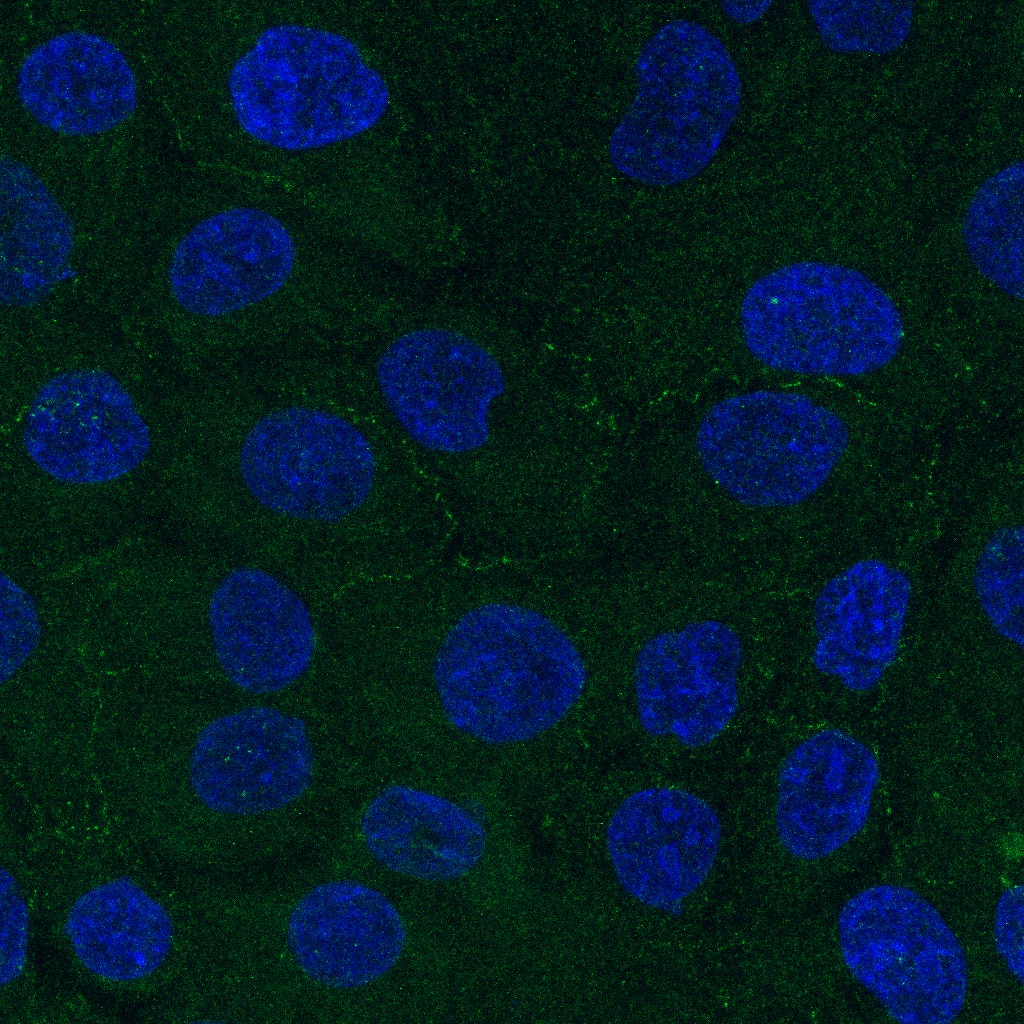 |
